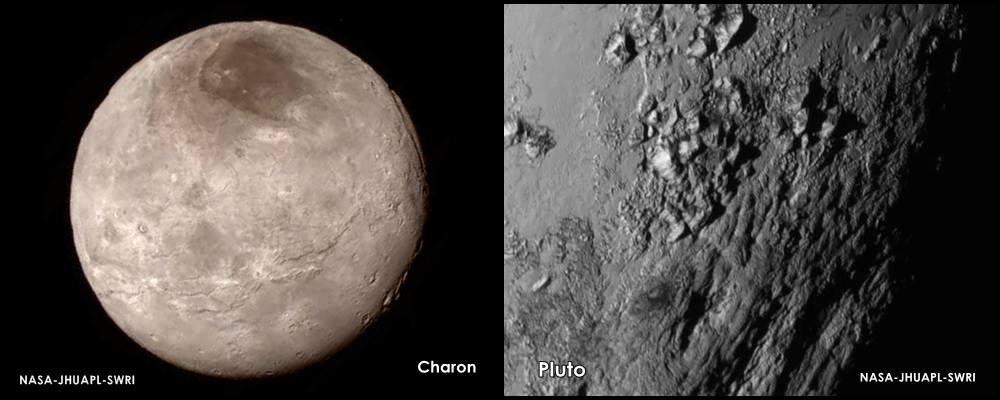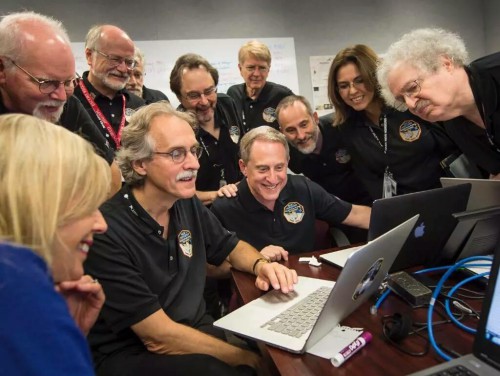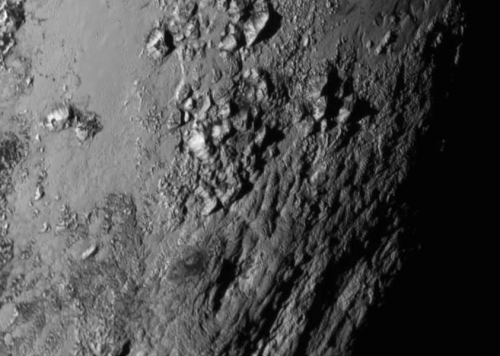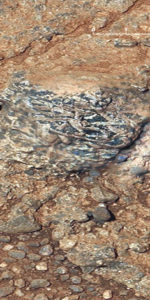
Yesterday, July 14, 2015, marked the first day in a new world where humanity has officially completed the initial reconnaissance of every planet in our Solar System. At 7:49 a.m. EDT Tuesday, NASA’s $728-million, piano-sized, 1,000-lb New Horizons spacecraft made its closest approach to Pluto and its largest moon, Charon, cruising 7,750 miles over the surface of Pluto and putting its suite of seven high-tech science instruments into overdrive as it cruised by at 31,000 mph, fulfilling its destiny after a 9.5-year journey across a vast expanse of 3 billion miles—some 32 times farther from the Sun than Earth.
Before yesterday’s flyby the spacecraft last communicated with Earth on Monday night, July 13, before falling silent for 22 hours as it focused 100 percent on conducting science observations that could only be done during the flyby itself through the Pluto system. At 8:53 p.m. EDT last night, the “phone home” was received in mission control at the Johns Hopkins University Applied Physics Laboratory in Laurel, Md., confirming that New Horizons’ flyby sequence worked and that it had accomplished its primary mission. Everything from the spacecraft’s power supply, its propulsion, and suite of science instruments reported back to Earth as alive and well.

But patience is the name of the game in planetary exploration. Pluto is so far away that round-trip radio communications between New Horizons and Earth takes nine hours—4.5 hours each way at the speed of light. And with New Horizons focused on Pluto observations, the mission team wanted to keep any communications with Earth to a minimum, allowing the science to be conducted at its maximum as the spacecraft flew by and went outbound from Pluto.
For nearly a decade the world has waited to see Pluto up close and personal. Today, those first close-ups made it home to Earth, via New Horizons’ mission control center at Johns Hopkins APL.
“Pluto New Horizons is a true mission of exploration showing us why basic scientific research is so important,” said John Grunsfeld, associate administrator for NASA’s Science Mission Directorate in Washington. “The mission has had nine years to build expectations about what we would see during closest approach to Pluto and Charon. Today, we get the first sampling of the scientific treasure collected during those critical moments, and I can tell you it dramatically surpasses those high expectations.”
In order to hit its target, on time and exactly where the science team wanted, the spacecraft had to “thread the needle” through a 36 x 57 mile (60 x 90 km) window in space—the equivalent of a commercial airliner arriving no more off target than the width of a tennis ball.
Today marks the beginning of a 16-month “data waterfall,” according to the mission’s Principal Investigator, Dr. Alan Stern, from the Southwest Research Institute in Boulder, Colo. The flyby may be over, but today the spacecraft began sending all of the information it collected to Earth, but at a transmission rate of only 2,000 bits per second. The mission team has likened it to opening Christmas presents every day for 16 months straight, and now the bounty of what they’ve collected is unfolding.
The flyby imagery is of such high-resolution that features as much as 230 feet wide will be crystal clear, and many times better than even the most recent image from July 13 on final approach, which showed Pluto at a resolution of nearly 8 miles per pixel. The flyby images will be so clear that if New Horizons was traveling over the Earth at the same distance, it would reveal detail as small as the ponds in New York’s Central Park.
“Home run!” said Alan Stern, principal investigator for New Horizons at the Southwest Research Institute (SwRI) in Boulder, Colo. “New Horizons is returning amazing results already. The data look absolutely gorgeous, and Pluto and Charon are just mind blowing.”

A range of mountains made of ice, rising 11,000 feet high, were arguably the most striking feature in the first close-up image of Pluto, taken near the world’s equator as New Horizons flew by at 7,750 feet above the surface. The mission team believes they likely formed no more than 100 million years ago, which is surprising considering the Solar System is over four billion years old.
This suggests the close-up region, which covers about 1 percent of Pluto’s surface, may still be geologically active today.
“This is one of the youngest surfaces we’ve ever seen in the solar system,” said Jeff Moore of the New Horizons Geology, Geophysics and Imaging Team (GGI) at NASA’s Ames Research Center in Moffett Field, Calif.

Rocky moons orbiting other planets in the Solar System are influenced and heated by the push and pull gravitational forces of their host worlds, processes that create such mountains and changing landscapes. Pluto, however, is not orbiting or being influenced by a host planet, it is the host planet, and so some other, still unknown, process must be generating the mountainous landscape.
What’s also surprising is a lack of craters on Pluto’s surface, suggesting something is going on, possibly internally, to erode the scars from impacts that have surely slammed Pluto over the eons.
“This may cause us to rethink what powers geological activity on many other icy worlds,” says GGI deputy team leader John Spencer at SwRI.
Pluto’s moon Charon is just as surprising; a young and dramatically varied terrain with very few craters was revealed in images from New Horizons. A swath of cliffs and troughs stretching some 600 miles across the surface suggests widespread fracturing of Charon’s crust, which is likely the result of internal geological processes. The image also shows a canyon estimated to be an incredible 4 to 6 miles deep.
In Charon’s north polar region, the dark surface markings have a diffuse boundary, suggesting a thin deposit or stain on the surface.
In high-contrast areas of the image, features as small as 3 miles (5 km) across can be seen. Some lower-contrast detail is obscured by the compression of the image, which may make some areas appear smoother than they really are. The uncompressed version still resides in New Horizons’ computer memory and is scheduled to be transmitted at a later date.
As New Horizons continues to make its way outbound from Pluto and into unchartered territory, the images will only get better and better as the data slowly returns to Earth over the next 16 months, writing the book on Pluto along the way.
It is hoped that NASA will approve an extended mission to explore another object farther out in the Kuiper Belt eventually, possibly even two if there is enough fuel, and a campaign currently underway to convince NASA to eventually upload a digital “Voyager Golden record 2.0” onboard the spacecraft now has the official support of New Horizons’ leader Alan Stern.
Stay with AmericaSpace for regular updates of New Horizons’ exploration of the Pluto system.
Be sure to “Like” AmericaSpace on Facebook and follow us on Twitter: @AmericaSpace
Missions » New Horizons »






this is far reaching as a question but can the hubble spacecraft see the new horizons spacecraft as it moves through space and how does it track it.And a last question when man finally get to mars whats next for man for deep space travel after mars missions are completred or what do we have our eyes/scientific minds aiming towards tyvm